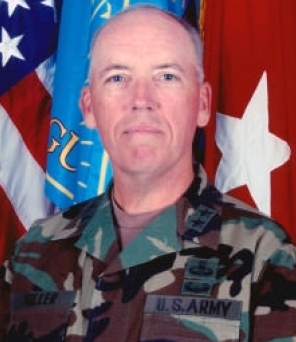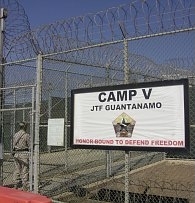
Mohammed Mani Ahmad al-Qahtani is a Saudi citizen who was detained as an al-Qaeda operative for 20 years in the United States's Guantanamo Bay detention camps in Cuba. Qahtani allegedly tried to enter the United States to take part in the September 11 attacks as the 20th hijacker and was due to be onboard United Airlines Flight 93 along with the four other hijackers. He was refused entry due to suspicions that he was trying to illegally immigrate. He was later captured in Afghanistan in the Battle of Tora Bora in December 2001.

Geoffrey D. Miller is a retired United States Army major general who commanded the US detention facilities at Guantanamo Bay, Cuba, and Iraq. Detention facilities in Iraq under his command included Abu Ghraib prison, Camp Cropper, and Camp Bucca. He is noted for having trained soldiers in using torture, or "enhanced interrogation techniques" in US euphemism, and for carrying out the "First Special Interrogation Plan," signed by the Secretary of Defense, against a Guantanamo detainee.

Camp Delta is a permanent American detainment camp at Guantanamo Bay that replaced the temporary facilities of Camp X-Ray. Its first facilities were built between 27 February and mid-April 2002 by Navy Seabees, Marine Engineers, and workers from Halliburton subsidiary Kellogg, Brown and Root. It is composed of detention camps 1 through 6, Camp Platinum, Camp Iguana, the Guantanamo psychiatric ward, Camp Echo and Camp No. The prisoners, referred to as detainees, have uncertain rights due to their location not on American soil. There are allegations of torture and abuse of prisoners.

Murat Kurnaz is a Turkish citizen and legal resident of Germany who was held in extrajudicial detention by the United States at its military base in Kandahar, Afghanistan and in the Guantanamo Bay detention camp at Guantanamo Bay Naval Base, Cuba beginning in December 2001. He was tortured in both places. By early 2002, intelligence officials of the United States and Germany had concluded that accusations against Kurnaz were groundless.

Shaker Abd al-Rahim Muhammad Aamer is a Saudi citizen who was held by the United States in the Guantanamo Bay detention camp in Cuba for more than thirteen years without charge.

The Guantanamo Bay detention camp is a United States military prison within the Guantanamo Bay Naval Base, also referred to as Gitmo, on the coast of Guantánamo Bay in Cuba. As of May 2024, of the 779 people detained there since January 2002 when the military prison first opened after the September 11 attacks, 740 had been transferred elsewhere, 30 remained there, and nine had died while in custody.
Abdul Rahman Ma'ath Thafir al Amri was a citizen of Saudi Arabia, held in extrajudicial detention as an enemy combatant in the United States Guantanamo Bay detainment camps, in Cuba.
The United States Department of Defense (DOD) had stopped reporting Guantanamo suicide attempts in 2002. In mid-2002 the DoD changed the way they classified suicide attempts, and enumerated them under other acts of "self-injurious behavior".
Yasser Talal al Zahrani was a citizen of Saudi Arabia who was held in extrajudicial detention in the United States Guantanamo Bay detainment camps, in Cuba. His Guantanamo Internment Serial Number was 93. The Department of Defense (DoD) reported that he was born on September 22, 1984, in Saudi Arabia. At the time of his capture, al-Zahrani was initially suspected of being "a front line fighter for the Taliban", though he was later considered "second line". He was also suspected of arranging weapons purchases.
Mani Shaman Turki al-Habardi Al-Utaybi (1976 – June 10, 2006) was a citizen of Saudi Arabia, who was arrested in 2001 in Pakistan and held in extrajudicial detention in the United States Guantanamo Bay detainment camps, in Cuba from early 2002. Al-Utaybi died in custody on June 10, 2006. The Department of Defense reported his death and those of two other detainees the same day as suicides.
Ali Abdullah Ahmed, also known as Salah Ahmed al-Salami, was a citizen of Yemen who died whilst being held as an enemy combatant in the United States Guantanamo Bay detainment camps, in Cuba. His Guantanamo Internment Serial Number was 693. Joint Task Force Guantanamo counter-terror analysts estimated he was born in 1977, in Ibb, Yemen.
Inayatullah, born Hajji Nassim (1974–2011) was a citizen of Afghanistan who was arrested in 2007 and transferred that year to be held as an enemy combatant in the United States Guantanamo Bay detainment camps, in Cuba. His Guantanamo Internment Serial Number was 10028. Nassim was held in Guantanamo for 3 years, 8 months, and 22 days until his death by apparent suicide. The US claims he admitted being an al Qaeda leader, but Nassim denied this in numerous interrogation sessions. The US military claims he was headquartered in Zahedan, Iran. Nassim was the 19th captive to have been transferred to Guantanamo since September 6, 2006.
Paul Rester is the director of the Joint Intelligence Group at the United States' Guantanamo Bay detention camps, in Cuba—the Chief Interrogator.
Carol Kisthardt is an American military lawyer and senior investigator with the national Naval Criminal Investigation Service. Kisthardt was a leading presenter on the role of the NCIS at numerous law enforcement conferences. She was a lead investigator in the investigations of Carlos and Elsa Alvarez, two Florida International University professors accused of spying for Cuba. In 2006, she investigated three suicides at Guantanamo Bay detention camp.
The Center for Policy and Research at Seton Hall University School of Law is a research organization that analyzes national policies and practices. Law students, participating in the Center as Research Fellows, work to identify factual patterns and inconsistencies in areas that help shape the law and public policy.
Camp No is an alleged secret detention and torture facility related to the United States detainment camps located in Guantánamo Bay, Cuba. On January 18, 2010, Scott Horton asserted in an article in Harper's Magazine, the result of a joint investigation with NBC News, that such a facility was maintained outside the regular boundaries of the Guantanamo Bay detention camps.
Guantanamo Bay homicide accusations were made regarding the deaths of three prisoners on June 10, 2006, at the United States Guantanamo Bay detention camp for enemy combatants at its naval base in Cuba. Two of the men had been cleared by the military for release. The United States Department of Defense (DOD) claimed their deaths at the time as suicides, although their families and the Saudi government argued against the findings, and numerous journalists have raised questions then and since. The DOD undertook an investigation by the Naval Criminal Investigative Service, published in redacted form in 2008.
In 2003, a secret compound, known as Strawberry Fields, was constructed near the main Guantanamo Bay detention camps, in Cuba. In August 2010 reporters found that it had been constructed to hold CIA detainees classified as "high value". These were among the many men known as ghost detainees, as they were ultimately held for years for interrogation by the CIA in its secret prisons known as black sites at various places in Europe, the Mideast, and Asia, including Afghanistan.
Dry-boarding is a torture method that induces the first stages of death by asphyxiation. Unlike waterboarding, where water is poured on a wet cloth placed over a supine subject's airways, so their breathing slowly fills their lungs with water, dryboarding induces asphyxiation through stuffing the subject's airways with rags, then taping shut their mouth and nose. It is among techniques used by the United States during its war on terror: CIA and military agents under the Bush administration described this as among enhanced interrogation techniques. It has since legally been defined by US courts as torture.





